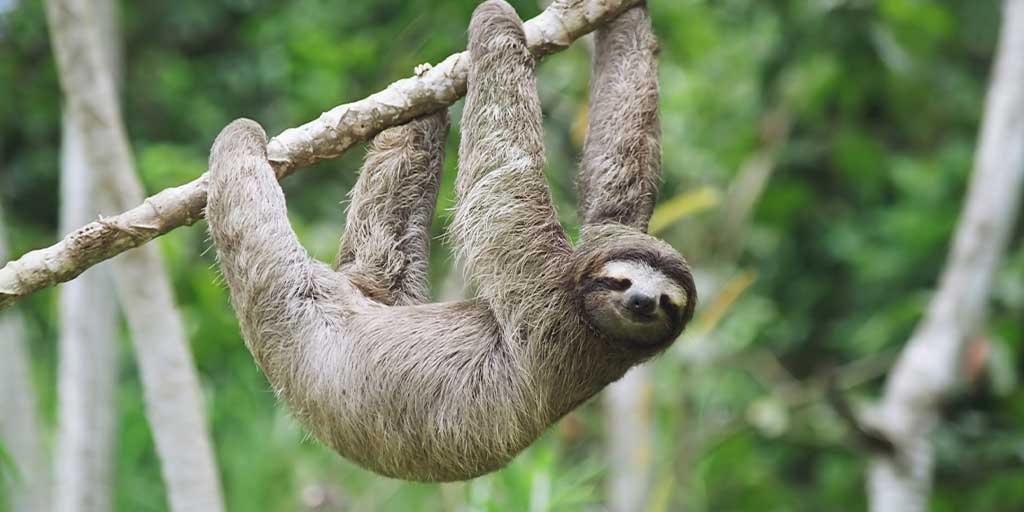Sloths. These slow-moving, baby-faced, tree-dwelling mammals have risen to stardom in recent years, with their chubby, bandit-masked faces appearing on everything from socks and t-shirts to coffee mugs and post-it notes. We can all agree they are cute, but how much do we know about them?

Five Fun Facts About Sloths (That at Least I Didn’t Know)
- Sloths are slow on land but speedy in water. Despite how slow they move on land; sloths are strong swimmers. They can move through water at three times the speed they can move over land. Three-toed sloths even have two extra vertebrae that allow their heads a wider range of motion and makes it easier for them to keep their noses above water.
- Sloths fluctuate their metabolic rate in a unique way. It takes a lot of energy to keep body temperature constant no mater what animal you are, but because sloths have the lowest metabolic rate of any mammal, they need to conserve energy wherever they can. As a result, they have developed a metabolic response to temperature that is unlike any other animal. At colder temperatures, their slow metabolic rate doesn’t offer enough energy to raise their body temperature, so it stays low. Much like reptiles, when it gets too cold, sloths look for a sunny spot to soak up some extra warmth. At high temperatures, however, they do something unexpected, they actively (albeit temporarily) depress their metabolic rate. So, when it gets too hot, sloths find a shady place to wait out the heat. By depressing their metabolic rate, they not only save energy but also reduce the amount of heat their body produces.
- Sloths’ fur is not green-tinged, they are just covered in algae. And fungi. And moths. When you move really slowly, you need to be well camouflaged to survive. For sloths, special cracks in their hair allow algae and fungi to grow and thrive. In fact, a whole ecosystem of invertebrates including beetles and moths can be found living in the fur of sloths, with a single sloth being able to play host to hundreds of moths and beetles at one time.
- Sloths only go to the bathroom once a week and can poop up to a third of their body weight at once. As much as I’d like to say scientists have a great explanation for the strange bathroom habits of sloths, the truth is we don’t know why they developed this behavior of returning to the ground once a week to relieve themselves. We do know that their digestive track (not surprisingly) moves very slowly. It can take them up to 30 days to digest a leaf.
- All sloths have three toes (on their back feet). Three-toes sloths also have three toes on their front feet (or hands), whereas two-toed sloths only have two. Some argue that they would be more appropriately called three-fingered and two-fingered sloths. No matter whether they have two or three toes (or fingers), sloths are incredibly strong. Their specialized musculature gives them enough strength to prevent them from being pulled out of a tree by predators. Their hands and feet can also lock into place, allowing them to hang upside down without expending a lot of energy. They can even sleep that way.
Bonus Fact: You should thank a sloth next time you eat guacamole. The (now extinct) giant ground sloths were one of the few mammals who could pass the large seeds of the avocado plant whole. As a result, these 15-foot creatures are credited with helping to disperse avocado plants during the early Cenozoic era, thousands of years before humans began enjoying the mashed fruit on tortilla chips or toast.
These are five (or six) things that I found interesting about sloths. There is certainly more to them than the cute, cuddly creature portrayed on t-shirts and mugs.
Three Things We Can Learn
Aside from amazing everyone with sloth trivia, there are also lessons that we could take from how these slow-moving tree dwellers approach life. Below are the three that I am going to try to be mindful of in my life.

- It is not always about “how fast”. Sloths have survived for thousands of years despite the excruciatingly slow pace at which they move through life. In contrast, it sometimes it feels like we are trying to live our lives as fast as we can. At work we’re asked, “How fast can you get this done?” At home we ask ourselves, “How fast can I get the house clean?” or tell our kids, “Hurry up” when they lag behind us as we walk. For many of us, even some of what we do to relax—running, biking, swimming— is focused on how fast we can do it. What if we paused from time to time and looked at that work task from a different angle? We might think of a different way to tackle it altogether. Instead of telling our kid to hurry up, what if we slowed down and let them show us what the world looks like through their eyes? What if we let ourselves enjoy each moment instead of rushing past it to the next?
- You don’t have to excel at everything. Put a sloth in a foot race and even the fabled turtle would probably be expected to beat them. Put them in water and they might surprise everyone. Challenge them to a dead hang contest; you’ll likely lose. Sloths aren’t the best (or fastest) at everything, but there are things they do well and things at which they excel. That is a good lesson for many of us. It is easy to get caught up in the perfectionist ideal of being great (or at least good) at everything we do or try. The truth is that this is an unreasonable (and exhausting) way to go through life. Instead of focusing so much energy on areas where we don’t excel, let’s start celebrating where we do.
- Hang on to the things that are important and let go of the things that aren’t. Sloths’ unique anatomy allows them to cling to a tree so tightly that jaguars and other predators can’t pull them down. Their survival is dependent on locking their hands and feet and hanging on when they need to, but when the danger has past, they also need to let go and move (slowly) on. How many of us have things in our lives that we are clinging to that aren’t jaguar-level important? What if we let go and moved (slowly) on?
Bonus Lesson: Resting in the sun on a cool day could help you conserve energy for later. In cooler conditions, sloths use the warmth and energy of the sun so that they don’t have to expend as much energy warming themselves. Could the same approach work for us? On the next cool day that you are tempted to grab a quick nap in a spot of warm sunlight, consider that by using the sun to stay warm, you could be conserving energy you can use to be productive later.
Kelly Grooms
Latest posts by Kelly Grooms (see all)
- The Battle of Shiloh’s Angel’s Glow: Fact, Civil War Legend or Modern Myth? - July 11, 2024
- Mind Control, Mutilation and Death. The Fungal Fate That Lurks in Waiting for Emerging Periodical Cicadas - June 13, 2024
- Measles and Immunosuppression—When Getting Well Means You Can Still Get Sick - May 13, 2024

One thoughtful comment